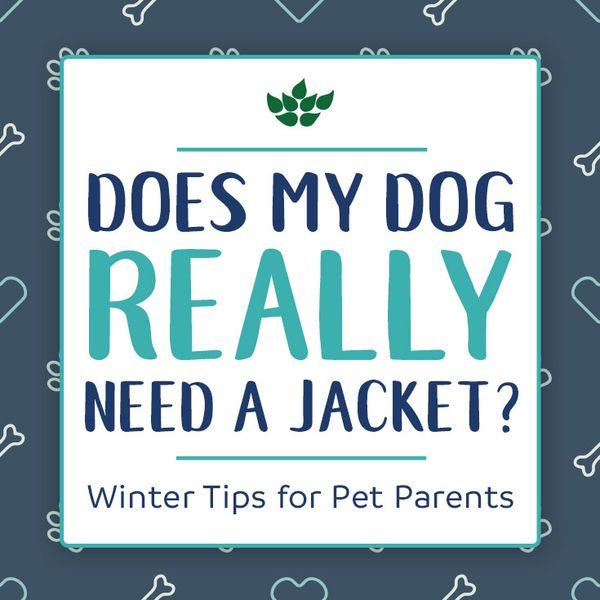Does My Dog Really Need a Jacket? Winter Tips for Pet Parents
It goes without saying that winter is tough. Cold temperatures, lack of sunlight, dry air, and poor driving conditions can make the season challenging. Your dog struggles during winter too! Just like humans, dogs are susceptible to dry and cracked skin, frostbite, and slips on icy walkways. Here are some useful tips and advice to keep your dog happy and safe during the winter months.
5 Basic Outdoor Safety Tips for Dogs
- Always keep a collar with current tags on your dog. You can purchase ID tags online or have them made at any major pet store. While a city license or rabies tag is helpful, they do not provide immediate contact information. By including your current phone number on your dog’s tags, you ensure your beloved pet gets back to you quickly. Microchips are also becoming a popular additional form of identification.
- Don’t leave your dog in the car unattended. Too many unfortunate incidents such as hypothermia, hyperthermia, theft, and more can occur. The risks simply aren’t worth it.
- Avoid having your dog off-leash. Even the most well-mannered dog can become distracted by a passing dog, car, or squirrel, potentially leading to tragedy.
- For the safety of both you and your dog, avoid using a flexi-leash (retractable leash). The length of some retractable leashes can extend up to 26 feet or more, making it hard to maintain proper control over your dog. Without this control, your dog could run into the street or confront an unfriendly animal, placing them in danger. Flexi-leashes also pose a risk to humans; entanglement can lead to injuries such as cuts, rashes, broken bones, burns, and even amputation in severe cases. (healthypets.mercola.com)
- Monitor your dog when they are outside. Dogs can access harmful chemicals if they can get into the garage or shed. Be mindful of what is in your yard as well. Sadly, it's not uncommon for malicious individuals to throw poisonous substances into yards that can harm dogs if ingested.
10 Winter Care and Safety Tips for Dogs
The most fundamental safety tip is not to leave your dog outside for extended periods. This is true in both summer and winter. Like humans, dogs need proper shelter and are prone to hypothermia, frostbite, and, in extreme cases, death. If you must leave your dog outside for extended periods, ensure they have access to a heated shelter and non-frozen water. Dogs deprived of fresh drinking water are more likely to consume harmful substances. Winter is also a common time for dogs to ingest antifreeze from puddles, which is sweet-tasting to them but almost always deadly.
- When outdoors with your dog, limit playtime to 20 to 30 minutes and ensure they wear appropriate winter gear.
- Go on frequent short walks to limit their exposure to the cold while still providing exercise.
- Know your dog’s tolerance for the cold. If your dog is shivering, trembling, whining, curling up their paws, or showing other signs of being cold, bring them to warmth immediately.
- To prevent slips and falls, especially for senior pets, use a pet-safe ice melt (such as Morton’s Safe-T-Pet® Ice Melt) to reduce ice and provide traction. Avoid using salt and other de-icers that can be harsh on a dog’s paw pads. Some ice melts are toxic if licked and ingested.
- Shovel paths in your yard so your dog can quickly and easily do their business and return inside.
- Wipe their feet each time they come inside. This removes chemicals such as ice melts and any built-up snow and ice between their pads.
- Dogs that are active outside during winter need more nutrition. Exercising in cold weather burns more calories since the body is also working to keep warm. Make sure to provide extra food to help maintain their current weight.
- Don’t shave your dog. Their fur protects them from the harsh elements.
- Be prepared. You should keep at least five days of dog food on hand in case of an emergency where you are unable to leave your home.
- Pet emergency survival kits can be a lifesaver. You can buy kits online or make your own at home with food, water, blankets, a first aid kit, dog bowls, leash, collar, and any necessary medications for your dog.
Winter Must-Haves for Dogs
Is your dog’s fur sufficient to keep them warm? Usually not! During winter, purchase outdoor gear for them to stay warm. Pets should also have access to warm options indoors. What are some essential products for pet owners in the winter?
For indoors:
- Thick blankets
- Burrow beds
For outdoors:
- Snoods and scarves
- Jackets, coats, sweaters
- Boots like Pawz
You can find most of your dog’s outdoor needs at any major or local pet store or on websites like Etsy for personalized and specific outerwear. Plus, it is fun to see what is available!
How to Make Your Own DIY Paw Balm
It is particularly important to maintain the condition of your dog’s paws and pads during winter. This can be achieved by wiping their paws frequently and using a paw protection balm. While many excellent balms are available for purchase, you can also make your own at home.
DIY Paw Balm – GoodDogsCo
Ingredients:
- 2 tablespoons olive oil
- 2 tablespoons coconut oil
- 1 tablespoon shea butter
- 1 tablespoon beeswax
Optional: Essential oils. CAUTION: Not all oils are safe for pets. Avoid high-phenol oils such as oregano, clove, and thyme; always dilute oils for pets and do not administer internally without consulting a veterinarian.
Directions:
- Melt all ingredients together in a pot over low heat until everything is melted and combined.
- Pour the mixture into a tin or other storage container. Be cautious if using metal or glass as the mixture will be very hot.
- Allow the balm to cool until hard. Cover, label, and store it for future use.
Outdoor Activities
Winter doesn’t mean you and your dog must completely avoid the outdoors. There are ways to make outside time fun and safe!
- Take short and frequent walks to exercise with your dog.
- Go on a quick trip to the dog park.
- Take some treats with you outside and have your dog smell them before hiding them around the yard in the snow.
If you can’t get outside during terrible weather days, try 11 popular indoor dog activities.
Winters can be tough, but with a bit of effort and preparation, they can still be enjoyable for both you and your pet!
What do you and your dog do during the winter? Does your dog have any favorite winter outer gear? Share a picture in the comments!
Sources:
Photos courtesy of:





Leave a comment